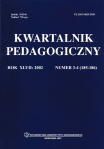Z dziejów myśli o tutoringu - krótki zarys historii indywidualnego kształcenia i wychowania
Tutoring - a short story of an individual education
Author(s): Adam FijałkowskiSubject(s): Education
Published by: Wydawnictwa Uniwersytetu Warszawskiego
Keywords: history of educatio; tutoring; individual education; educational traditions; Poland and Great Britain
Summary/Abstract: A tutorial is one method of interactive knowledge transferring and may be used as a part of learning in a small group of pupils or students. A tutorial can take one of many forms – depending on its context. In British academic life, especially at the University of Oxford and at the University of Cambridge, a tutorial means a small class of one, or only a few (up to three) students, in which the tutor (academic staff member) gives individual attention to the students who are expected to prepare an essay. At some Polish universities, like at some universities in the USA, Canada and Central Europe, a tutorial refers to something more like a recitation, that is, a class of between 12–18 students that supplements a large lecture course, which gives students an opportunity to discuss the lectures and additional readings in smaller groups. The text, however, is devoted to the classical, British meaning of a tutorial – as a form of individual learning, in its historical context. The word “tutor” can be found in the Codex Iuris Civilis (CIC) of Justinian, in the Institutiones. A tutor was a legal guardian to care for the personal and property of a child – called a pupil. In the Middle Ages tutors and pupils were found in monastery schools and universities in France, Germany, Italy and England. A tutor was usually a monk who took individual care of pupils – students in a school or a college, prepared them for classes, discussions, exams, but also academic customs, forms of everyday life etc. A tutor was responsible not just for a training and an individual teaching of his pupil, but also for his individual manners. In the early modern times, tutors were not only monks or clerics in a given college, but also secular scholars or older students who assisted their pupils also in educational trips to many schools or universities in Europe. The classical author of such an individual education was Michel de Montaigne (1533–1592) – a French humanist. In his Essays (1580), Montaigne criticized humanistic schools and colleges – a “school of equal chances”, as described by Marcus Fabius Quintilian (1 century AD), Juan Luis st is Vives (1492–1540), and optioned for a very individual education. In England, John Locke (1632–1704) formulated similar postulates for an individual education. Tutors, individual teachers or preceptors, can quite often be found in historical sources in Western and Central Europe, also in Poland, before the Age of the Enlightenment. The Enlightenment and reforms of schools and universities on the European continent in 18/19th centuries gave up that form of an individual education because of its relative high costs. However, tutorials remained in British universities of Oxford and Cambridge – even after reforms in the second half of the 19th century and even after the Second World War and in the 1960s. The question is, whether that form of individual training and manners is or should be introduced also at Polish universities.
Journal: Kwartalnik Pedagogiczny
- Issue Year: 216/2009
- Issue No: 2
- Page Range: 5-34
- Page Count: 30
- Language: Polish
- Content File-PDF

